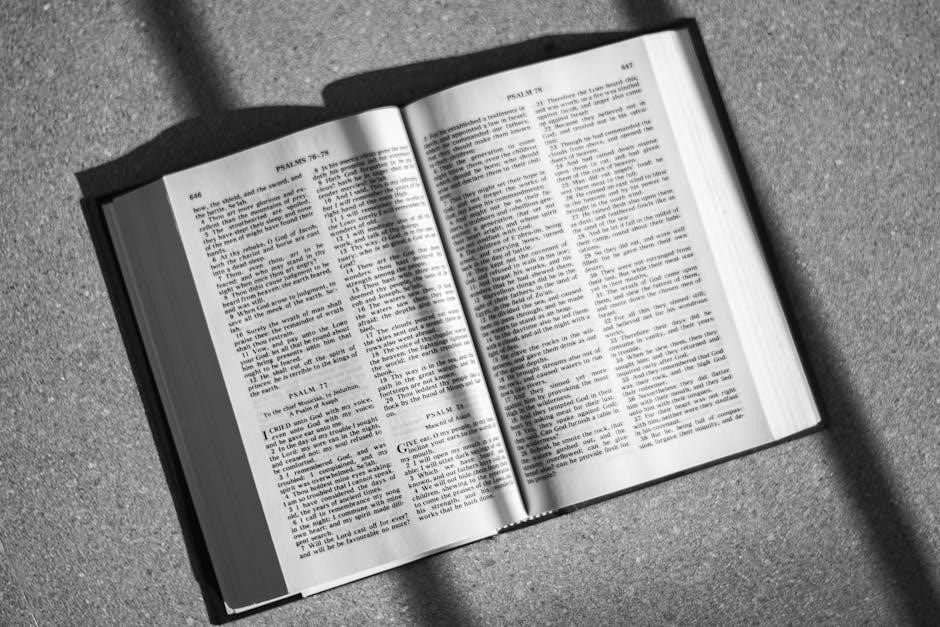
Biblical types and shadows are prefigurations of New Testament truths, revealing deeper spiritual realities through symbolic people, events, and objects, enriching our understanding of redemption and divine plans.
Overview of Biblical Typology
Biblical typology is the study of types and shadows, which are symbolic representations in the Old Testament that prefigure New Testament realities. These types include people, events, and objects that foreshadow divine truths, such as Christ, the church, and redemption. The Old Testament serves as a preparatory ground, with its ceremonies, sacrifices, and historical events pointing to greater spiritual realities fulfilled in the New Testament. Understanding typology enriches biblical interpretation, revealing how God’s plan of salvation unfolds progressively through scripture. It bridges the Testaments, demonstrating continuity and the fulfillment of prophecy, offering deeper insights into God’s nature and redemptive purposes.
Significance of Types and Shadows in Understanding Scripture
Types and shadows in the Bible are essential for understanding divine truths, as they foreshadow New Testament realities. These symbolic representations bridge the Old and New Testaments, revealing God’s redemptive plan progressively. They illustrate key themes like salvation, priesthood, and divine judgment, providing depth to biblical interpretation. By studying these typologies, believers gain insight into Christ’s nature, the church’s role, and end-time events. This theological framework enriches faith, offering a cohesive view of scripture. It also helps modern Christians apply ancient truths to contemporary life, fostering spiritual growth and a deeper connection to God’s Word.

Defining Types and Shadows
Types are prophetic representations of future realities, while shadows symbolize divine truths, providing a deeper understanding of God’s plan through symbolic imagery and prefiguration in scripture.
Types: Prefigures of New Testament Realities
Types in the Bible are prophetic representations that foreshadow New Testament truths, such as the resurrection of Christ, divine redemption, and the establishment of the Church.
Shadows: Symbolic Representations of Future Events
Shadows in Scripture are symbolic representations that point to future events, such as divine judgment, deliverance, and the ultimate triumph of God’s plan, enriching our understanding of His redemptive narrative.

Types of Christ in the Old Testament
Old Testament figures like Adam, Melchizedek, and Joseph serve as types of Christ, foreshadowing His nature, mission, and redemptive work, providing profound insights into God’s divine plan.
Adam: The First Adam and the Last Adam
Adam, as the first created man, represents humanity’s original state and sin nature, while Christ, the Last Adam, redeems this through His sacrifice, fulfilling God’s plan of salvation. Adam’s disobedience introduced sin and death, contrasting with Christ’s obedience and gift of eternal life. This typology highlights the transition from condemnation to justification, emphasizing Christ’s role as the Second Adam who restores humanity’s relationship with God. This contrast underscores the redemptive narrative of Scripture, illustrating how Christ fulfills and transcends the failures of the first Adam, offering new life and righteousness to all believers.
Melchizedek: A Type of Christ’s Priesthood
Melchizedek, a mysterious figure in Genesis 14, serves as a type of Christ’s priesthood. As a priest of God Most High, he blesses Abram and receives a tithe, symbolizing Christ’s authority. In Hebrews, Melchizedek’s priesthood is contrasted with the Levitical system, emphasizing its superiority and eternal nature. Like Melchizedek, Christ’s priesthood is without lineage or succession, offering a once-for-all sacrifice. This typology highlights Christ’s role as the ultimate High Priest, mediating between God and humanity, fulfilling the shadowy representation of Melchizedek’s ministry. Through this, the Bible illustrates the redemptive plan, where Christ’s priesthood surpasses all earthly forms, providing eternal redemption and access to God.
Joseph: A Shadow of Christ’s Life and Ministry
Joseph’s life remarkably parallels Christ’s, serving as a shadow of His ministry. Both were beloved sons, rejected by their own, and falsely accused. Joseph’s betrayal by his brothers and subsequent rise to authority mirror Christ’s rejection and exaltation. His role as a savior to his family, providing sustenance during famine, foreshadows Christ’s role as the Bread of Life. Joseph’s forgiveness and restoration of his brothers reflect Christ’s redemption and grace. This typology underscores divine providence and redemption, illustrating how Joseph’s experiences prefigure the Messiah’s mission to save and restore humanity, offering a profound example of God’s redemptive plan revealed through Old Testament figures.
Types of the Antichrist
The Bible presents Cain and Judas as types of the Antichrist, embodying deception, betrayal, and opposition to God’s plan, foreshadowing the ultimate adversary’s spirit and actions.
Cain: The First Murderer and Deceiver
Cain, the firstborn of Adam and Eve, is a significant type of the Antichrist, exemplifying rebellion, jealousy, and deception. His murder of Abel, motivated by envy and pride, symbolizes the spirit of antichrist, which opposes righteousness and God’s plan. Cain’s refusal to acknowledge his sin and his attempt to deceive God highlight his deceptive nature, mirroring the Antichrist’s role as a liar and deceiver. His punishment and wandering illustrate the consequences of rejecting God, serving as a warning against sin and rebellion. Cain’s actions foreshadow the Antichrist’s hatred for the righteous and his ultimate destruction.
Judas Iscariot: Betrayal and Rejection
Judas Iscariot, one of Jesus’ twelve apostles, is a profound type of the Antichrist, embodying betrayal and rejection. His infamous act of betraying Jesus for thirty pieces of silver fulfilled Old Testament prophecies, symbolizing the spirit of antichrist. Judas’s actions reveal a heart of deception, greed, and rebellion, aligning with the Antichrist’s nature. His ultimate remorse and tragic death serve as a cautionary tale, illustrating the consequences of rejecting God’s truth. Judas’s betrayal not only led to Jesus’ crucifixion but also foreshadowed the Antichrist’s role in opposing Christ and leading others astray, making him a significant shadow of end-time deception and rebellion.

Types of the Church
The Church is symbolized as the Bride of Christ and the Body of Christ, reflecting unity, holiness, and spiritual union with God through the Holy Spirit.
Israel: The Bride of God
Israel is depicted as the Bride of God, symbolizing a divine covenant relationship. This typology reflects spiritual union, covenant faithfulness, and redemption, foreshadowing Christ’s relationship with His Church. Through Israel’s journey, God’s love, mercy, and redemptive plan are illustrated, emphasizing the Bride’s ultimate restoration and union with Him. This shadow finds fulfillment in Christ’s Bride, the Church, highlighting eternal covenant promises and divine love. The imagery underscores spiritual marriage, sanctification, and the ultimate union of believers with Christ, enriched by biblical typology and symbolic representations, providing profound insights into God’s relational and redemptive nature. This theme is central to biblical typology and theology.
The Tabernacle: A Shadow of the Church
The Tabernacle, a portable place of worship, symbolizes the Church as God’s dwelling among His people. Its structure—Holy Place and Most Holy Place—reflects the Church’s role as a sacred vessel for divine presence. The Tabernacle’s furnishings, such as the altar, lampstand, and ark, typify Christ’s redemptive work and the Church’s spiritual functions. The veils separating sacred spaces symbolize Christ’s torn flesh, granting access to God’s presence. The Tabernacle’s construction from free-will offerings mirrors the Church, built with living stones, each member contributing to God’s eternal habitation. This shadow emphasizes the Church as a spiritual temple, indwelt by the Holy Spirit, fulfilling the Tabernacle’s ultimate purpose.

Types of the Rapture
The Rapture is typified in biblical figures like Enoch and Elijah, who were caught up to heaven without experiencing death, symbolizing the Church’s future glorification and departure.
Elijah: Caught Up to Heaven
Elijah, a prophet in the Old Testament, is a significant type of the Rapture. His miraculous ascension in a chariot of fire, as recorded in 2 Kings 2:11-12, symbolizes the sudden and glorious departure of believers. Unlike Enoch, who was translated without death, Elijah’s catching up to heaven in a fiery chariot represents the dramatic nature of the Rapture. This event foreshadows the hope of believers being caught up to meet the Lord in the air, emphasizing the supernatural and instantaneous nature of the Rapture. Elijah’s story serves as a powerful reminder of God’s divine plan for His people’s deliverance and glorification.
Enoch: A Type of the Rapture
Enoch, a righteous man in Genesis, is a profound type of the Rapture. His translation without seeing death (Genesis 5:24) symbolizes the believer’s hope of being caught up to heaven. Unlike Elijah, who was taken up in a fiery chariot, Enoch’s departure was quiet and sudden, emphasizing God’s sovereign grace. His life demonstrated faith and pleasing God, foreshadowing the Rapture’s promise of believers being suddenly removed from the earth. Enoch’s story illustrates the assurance of eternal life and the ultimate deliverance of God’s people, serving as a powerful typological representation of the Rapture’s glorious and unexpected nature.

Types of the End of the Age
The Bible uses symbolic events to foreshadow the end of the age, such as the Day of the Lord, representing divine judgment and refining fire, preparing for restoration.
The Flood: A Shadow of Divine Judgment
The Flood, a catastrophic event in Genesis, serves as a shadow of divine judgment, illustrating God’s response to wickedness. It prefigures the end-time judgment, where sin will be purged, and righteousness restored. Noah’s salvation through faith and obedience symbolizes deliverance for the righteous, foreshadowing salvation in Christ. The Flood’s destruction and renewal parallel future events, emphasizing God’s mercy and justice. This historical event underscores the consequences of sin and the hope of redemption, aligning with biblical themes of purification and ultimate restoration through divine intervention.
- Represents divine judgment and purification.
- Prefigures the end-time reckoning.
- Illustrates salvation through faith and obedience.
Sodom and Gomorrah: Destruction and Deliverance
The destruction of Sodom and Gomorrah serves as a shadow of divine judgment, illustrating God’s response to unrepented sin and corruption. The cities’ wickedness led to their annihilation by fire, symbolizing future judgment. Lot’s deliverance, despite his compromised faith, represents divine mercy toward the righteous. The transformation of Lot’s wife into a pillar of salt warns against looking back to worldly desires. This event foreshadows end-time scenarios, emphasizing the importance of righteousness and separation from sin. It underscores God’s justice and the ultimate deliverance of His people, aligning with biblical themes of purification and redemption through divine intervention.
- Symbolizes divine judgment on sin.
- Represents deliverance for the righteous.
- Warns against worldly attachments.
Types of the Holy Spirit
The Holy Spirit is symbolized by the dove, representing peace and purity, and the wind, signifying power and divine movement, reflecting His divine nature and ministry.
The Dove: Symbol of the Holy Spirit
The dove is a profound symbol of the Holy Spirit, appearing in both the Old and New Testaments. It first appears in Genesis 8:8-12, where Noah releases a dove to determine if the floodwaters have receded. The dove returns with an olive leaf, symbolizing peace and new life. This imagery parallels the Holy Spirit’s role in bringing peace and renewal. In the New Testament, the dove descends upon Jesus during His baptism, as recorded in Matthew 3:16 and Luke 3:22, signifying divine approval and the beginning of Christ’s ministry. This symbol underscores the Holy Spirit’s gentle yet transformative power in the lives of believers.
The Wind: Representing the Holy Spirit’s Power
The wind is a significant symbol of the Holy Spirit’s power and presence throughout Scripture. In John 3:8, Jesus compares the Spirit to the wind, emphasizing its invisible yet profound impact. The Hebrew word for “Spirit” (ruach) also means “breath” or “wind,” highlighting its life-giving nature. In Ezekiel 37:9-10, the prophet calls for the “breath of the Lord” to bring life to dry bones, symbolizing spiritual renewal. Similarly, Acts 2:2-4 describes the Holy Spirit’s arrival at Pentecost with a mighty rushing wind, signifying divine power and transformation. The wind thus represents the Spirit’s dynamic and rejuvenating work in the lives of believers.

Types of Satan
The serpent symbolizes Satan’s deception, as seen in Genesis, while Leviathan represents his chaotic power, reflecting his opposition to God’s order and truth in Scripture.
The Serpent: Deception and Temptation
The serpent in Genesis embodies Satan’s deceptive nature, luring humanity into sin through cunning and false promises. This symbol reflects Satan’s role as the ultimate deceiver, opposing God’s truth and leading humanity away from divine fellowship. The serpent’s craftiness parallels Satan’s strategies in tempting believers today, highlighting the ongoing spiritual battle between good and evil. By understanding this type, Christians gain insight into Satan’s methods, emphasizing the need for vigilance and reliance on God’s Word to resist deception. This biblical imagery underscores the serpent’s enduring representation of temptation and the adversary’s persistent influence throughout history.
Leviathan: A Symbol of Satan’s Power
Leviathan, described in Job, Psalms, and Isaiah, symbolizes Satan’s immense power and dominance over chaos and evil. This monstrous sea creature embodies the forces of darkness and rebellion against God. In biblical typology, Leviathan represents Satan’s strength and his role as the ruler of the kingdom of darkness. Its depiction as an unmanageable beast highlights the futility of human efforts to control evil without divine intervention. Leviathan’s imagery serves as a reminder of Satan’s authority over the spiritual realm and his opposition to God’s order, underscoring the spiritual warfare Christians face and the necessity of relying on God’s power for victory.

Types of the Resurrection
Lazarus’s resurrection by Jesus symbolizes Christ’s power over death, foreshadowing His own resurrection and the promise of eternal life for believers through faith in Him.
Lazarus: A Shadow of Christ’s Resurrection
Lazarus, raised from the dead by Jesus in John 11, serves as a profound shadow of Christ’s resurrection. His death and burial symbolize spiritual death, while his resurrection mirrors Christ’s victory over sin and death. Jesus’s statement, “I am the resurrection and the life,” highlights the ultimate fulfillment of this shadow in His own resurrection. Lazarus’s restoration to life foreshadows the eternal life believers receive through faith in Christ, emphasizing the power of God over death and the hope of eternal redemption. This event underscores the theological connection between Old Testament shadows and New Testament realities.
Joni: A Type of Resurrection and New Life
Joni, though not explicitly named in the Bible, symbolizes resurrection and new life through her miraculous story. Her three days in the belly of a great fish prefigure Christ’s resurrection, as Jonah’s deliverance mirrors Christ’s triumph over death. Jonah’s emergence from the fish represents spiritual rebirth, while his preaching in Nineveh signifies the call to repentance and new life in Christ. This typology highlights the redemptive plan of God, showcasing salvation’s universality and the transformative power of faith. Jonah’s story serves as a vivid shadow of Christ’s resurrection and the eternal hope of new life offered through Him to all humanity.

Types of the Second Coming
Old Testament figures like Joshua and David serve as types, foreshadowing Christ’s triumphant return. Their leadership and victories symbolize His second coming, restoring God’s people and reign.
Joshua: Leading God’s People
Joshua’s leadership in conquering Canaan symbolizes Christ’s second coming. As Joshua led Israel into the Promised Land, Christ will lead His people into eternal rest and victory over sin.
David: A King and Shepherd
David, as a king and shepherd, typifies Christ’s dual role as a ruler and caretaker of God’s people. His reign over Israel foreshadows Christ’s messianic kingdom, where He will reign with justice and compassion.
Like Christ, David trusted God amidst challenges, exemplifying humility and divine authority. His victories and leadership symbolize Christ’s triumph over sin and His role as the Good Shepherd, guiding and protecting His flock. David’s lineage also points to Christ, emphasizing His royal and redemptive mission, fulfilling God’s promise of an eternal kingdom through His second coming.

Types of the Millennium
The Millennium is symbolized by the Sabbath, representing rest, and the Jubilee, signifying freedom and restoration, both foreshadowing Christ’s future reign and earthly kingdom.
The Sabbath: Rest and Rejuvenation
The Sabbath, a day of rest, symbolizes spiritual rejuvenation and trust in God’s provision, foreshadowing the ultimate rest found in Christ’s redemptive work. It reflects humanity’s need to cease from labor, emphasizing faith in divine sovereignty. Originally a command for Israel, the Sabbath points to the Millennial rest under Christ’s reign, where believers will experience true peace and restoration. While the physical Sabbath was a shadow, the substance is in Christ, offering believers spiritual rest through His finished work. This typology highlights the harmony between Old Testament practices and New Testament realities, illustrating God’s plan for eternal rest and renewal.
The Jubilee: Freedom and Restoration
The Jubilee, a 50th-year celebration, symbolizes freedom, restoration, and redemption, foreshadowing Christ’s victorious work. It involved releasing slaves, restoring land, and renewing communities, mirroring Christ’s mission to liberate humanity from sin. This practice, rooted in Leviticus, highlights God’s heart for justice and equity, pointing to the ultimate liberation through Christ’s sacrifice. The Jubilee’s emphasis on return and restoration parallels the Millennial reign, where all creation will be freed from bondage and restored to God’s intended order. This typology underscores the deeper spiritual realities of redemption, freedom, and eternal restoration found in Christ, fulfilling the shadows of the Old Testament.
The study of types and shadows enriches biblical understanding, revealing deep spiritual truths and connecting believers to God’s redemptive plan across scripture.
Summarizing the Importance of Types and Shadows
Types and shadows are foundational to understanding biblical theology, connecting Old Testament symbols to New Testament realities. They reveal God’s consistent plan of redemption, providing depth and clarity to scripture. By studying these prefigurations, believers gain insight into Christ’s mission, the church’s role, and future events. Types and shadows serve as divine illustrations, bridging the gap between testaments and enriching spiritual understanding. They underscore God’s sovereignty and the unity of His Word, offering practical applications for modern Christianity. This typological framework empowers believers to appreciate the richness of scripture and live in alignment with God’s revealed truths, fostering a deeper faith and walk with Him.
Applying Typological Understanding in Modern Christianity
Typological understanding equips believers to discern spiritual truths, enriching worship and deepening faith. It bridges the Old and New Testaments, revealing Christ as the fulfillment of all types and shadows. By recognizing these patterns, Christians can better grasp God’s plan, fostering unity and clarity in doctrine. Practical application includes enhanced Bible study, informed discipleship, and a stronger connection to the overarching narrative of redemption. This timeless framework encourages believers to live in light of biblical truths, empowering them to navigate life’s challenges with wisdom and assurance, rooted in the rich tapestry of God’s Word and its enduring relevance for today’s world.